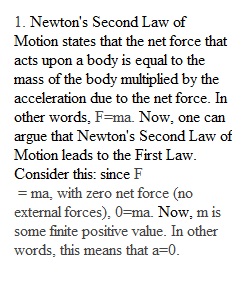


Q This assignment supports the following Unit Objectives: • (U53) Explain the relationship between the variables in Newton's Laws (CLO4) • (U63) Define normal force and the coefficient of friction. (CLO4) • (U64) Explain the role of the normal force and the coefficient of friction in motion. (CLO4) • (U65) Recognize and use appropriate units for motion with friction (CLO2)(CLO4) • (U66) Calculate the coefficient of friction, the normal force, and the friction force (CLO2) • (U67) Explain how friction effects motion (CLO4) • (UDS) Develop a well thought out and correct response to various discussion questions(CLO2)(CLO4)(Goal 4) Do not start a new thread. Simply reply to my posting. Be sure to comment on at least two of your classmates' postings. Your replies must be more than a simple phrase like "I agree" or "I like your answers". Replies should reflect on why you agree or like what has been posted. Your replies must reflect a genuine effort to engage your fellow classmates regarding the comments provided or the problem that has been solved. Please post your responses here. 1. Newton's 2nd Law of motion can be thought of as a mathematical explanation of the first law. Explain why that is the case. 2. Give an example of Newton's 3rd Law of motion. What is the practical effect? (How does it affect the motion of the two objects; you can use an example to better illustrate.) 3. What is the difference between a negative acceleration and deceleration. Give an example that illustrates this difference. 4. When sliding a heavy object across a surface, is it easier (requiring less force) to pull the object at an angle of 30o upward compared to the horizontal or push downward at an angle of 30o to the horizontal. Explain. Assume the surface is flat.
View Related Questions